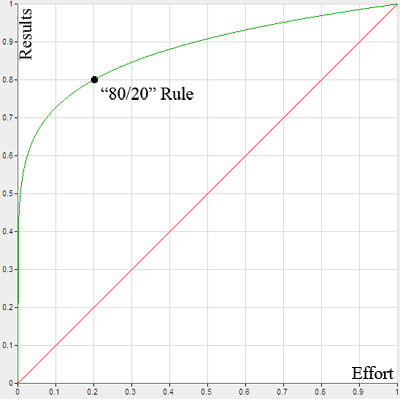Originally, the Pareto Principle referred to the observation that 80% of Italy’s wealth belonged to only 20% of the population.
More generally, the Pareto Principle is the observation (not law) that most things in life are not distributed evenly. It can mean all of the following things:
- 20% of the input creates 80% of the result
- 20% of the workers produce 80% of the result
- 20% of the customers create 80% of the revenue
- 20% of the bugs cause 80% of the crashes
- 20% of the features cause 80% of the usage
- And on and on…
But be careful when using this idea! First, there’s a common misconception that the numbers 20 and 80 must add to 100 — they don’t!
20% of the workers could create 10% of the result. Or 50%. Or 80%. Or 99%, or even 100%. Think about it — in a group of 100 workers, 20 could do all the work while the other 80 goof off. In that case, 20% of the workers did 100% of the work. Remember that the 80/20 rule is a rough guide about typical distributions.
Also recognize that the numbers don’t have to be “20%” and “80%” exactly. The key point is that most things in life (effort, reward, output) are not distributed evenly – some contribute more than others.
Life Isn’t Fair
What does it mean when we say “things aren’t distributed evenly”? The key point is that each unit of work (or time) doesn’t contribute the same amount.
In a perfect world, every employee would contribute the same amount, every bug would be equally important, every feature would be equally loved by users. Planning would be so easy.
But that isn’t always the case:

The 80/20 rule observes that most things have an unequal distribution. Out of 5 things, perhaps 1 will be “cool”. That cool thing/idea/person will result in majority of the impact of the group (the green line). We’d like life to be like the red line, where every piece contributes equally, but that doesn’t always happen.
Of course, this ratio can change. It could be 80/20, 90/10, or 90/20 (remember, the numbers don’t have to add to 100!).
The key point is that most things are not 1/1, where each unit of “input” (effort, time, labor) contributes exactly the same amount of output.
So Why Is This Useful?
The Pareto Principle helps you realize that the majority of results come from a minority of inputs. Knowing this, if…
20% of workers contribute 80% of results: Focus on rewarding these employees.
20% of bugs contribute 80% of crashes: Focus on fixing these bugs first.
20% of customers contribute 80% of revenue: Focus on satisfying these customers.
The examples go on. The point is to realize that you can often focus your effort on the 20% that makes a difference, instead of the 80% that doesn’t add much.
In economics terms, there is diminishing marginal benefit. This is related to the law of diminishing returns: each additional hour of effort, each extra worker is adding less “oomph” to the final result. By the end, you are spending lots of time on the minor details.
A Fun, Non-Math Example, Please
Everything is nice and rosy in the abstract. I want to give you a real example. Take a look at this awesome video of an artist drawing a car in Microsoft Paint. It’s pretty phenomenal what can be accomplished with such a basic tool:
Now let’s deconstruct this video. It’s about 5 minutes long, so each minute is about 20% of the way to completion (of course the video is sped up, but we are only interested in relative times anyway). Take a look at how the car evolved over time:

|
1:06 (Level 1) – Wireframe |

|
2:00 (Level 2) – Basic coloring |

|
3:05 (Level 3) – Beginning details: rims, windshield |

|
4:04 (Level 4) – Advanced details: shading, reflections |

|
5:05 (Level 5) – Finishing touches: headlights, background |
Now, let’s say the artist was creating potential designs for a client. Given 5 minutes of time, he could present:
- A single car at top quality (Level 5)
- A reasonably detailed car (Level 3) and a colorized wireframe (Level 2)
- 5 cars at a wireframe level (5 Level 1s)
“But Level 5 is way better than Level 1!” someone will inevitably shout.
The point isn’t that Level 5 is better than Level 1 — it clearly is. The question is whether a single Level 5 is better than five Level 1s, or some other combination.
Let’s say your customer doesn’t know whether they want a car, a truck, or a boat, let alone the color. Spending the time to create a Level 5 drawing wouldn’t make sense — show some concepts, get a general direction, and then work out the details.
The point is to put in the amount of effort needed to get the most bang for your buck — it’s usually in the first 20% (or 10%, or 30% — the exact amount can vary). In the planning stage, it may be better to get 5 fast prototypes rather than 1 polished product.
In this example, after 1 minute (20% of the time) we have a great understanding of what the final outcome will be. Most of the “work” is done up front, in the sense of deciding the type of vehicle, body style, and perspective. The rest is “filling in details” like colors and shading.
This isn’t to say the details are easy — they’re not — but each detail does not add as much to the picture as the broad strokes in the beginning. The difference between #4 and #5 is not as great as #1 and #2, or better yet, a blank drawing and #1 (the time from 0:00 to 1:06). You really have to look to see the differences on the car between #4 and #5, while the contribution #1 makes is quite obvious.
Concluding Thoughts
This may not be the best strategy in every case. The point of the Pareto principle is to recognize that most things in life are not distributed evenly. Make decisions on allocating time, resources and effort based on this:
- Instead of spending 1 hour drafting a paper/blog post you’re not sure is needed, spend 10 minutes thinking of ideas. Then spend 50 minutes writing about the best one.
- Instead of agonizing 3 hours on a single design, make 6 layouts (30 minutes each) and pick your favorite.
- Rather than spending 3 hours to read 3 articles in depth, spend 5 minutes glancing through 12 articles (1 hour) and then spend an hour each on the two best ones (2 hours).
These techniques may or may not make sense – the point is to realize you have the option to focus on the important 20%.
Lastly, don’t think the Pareto Principle means only do 80% of the work needed. It may be true that 80% of a bridge is built in the first 20% of the time, but you still need the rest of the bridge in order for it to work. It may be true that 80% of the Mona Lisa was painted in the first 20% of the time, but it wouldn’t be the masterpiece it is without all the details. The Pareto Principle is an observation, not a law of nature.
When you are seeking top quality, you need all 100%. When you are trying to optimize your bang for the buck, focusing on the critical 20% is a time-saver. See what activities generate the most results and give them your appropriate attention.




Leave a Reply
217 Comments on "Understanding the Pareto Principle (The 80/20 Rule)"
It exist an outdated network designer rule that’s called “The 80/20 rule”. It says that 80% of the network traffic should be internal and 20% should be external. Today it’s more like 20/80 ^^
My “Strategic Management of Technology and Innovation” class loved this interpretation of the “Pareto Principle”. It was done with a video they could relate to.
Hi Christina, I’m glad your class liked it! Yes, there’s many examples out there which are more interesting than “Worker A does 80% of his work in 20% of the time”. Thanks for dropping by.
[…] This video was also a great example of the 80/20 rule. In 3 minutes you got the gist of the presentation. Would it have been 10-times better if it was 30 minutes long? No. […]
[…] A great breakdown of that good old 80/20 rule (otherwise known as the Pareto Principle) that seems to pop up everywhere. […]
Kalid, your site is great! Regarding the Pareto principle, have you read Mandelbrot’s book “The (Mis) Behavior of Markets?” His was the first treatment I’d encountered of Pareto’s work, and was very enlightening.
Hi Bernard, thanks for the comment! That sounds like an interesting book, I’ll have to add it to the reading list :)
Lovely page to explain the Pareto principle … and the videos to support the understanding are excellent. Hope to see such pages on more topics.
Thanks Amit! I like finding different explanations for things (vs. using typical “business” metrics like worker productivity), and I’m glad you enjoyed it. I’ll try to keep the posts coming.
Have been using this concept, just didn’t know it had a name…and such structure.
I do collage assembly for stress management issues. In order to clarify focus for a topic/theme for the collage the questions asked require one to seperate behavior from emotions.
80% of the behavior is dictated by 20% of our emotions.
example:
Person acts angry all the time. They are short tempered and easily angered. They snap at any correction or observation no matter how well intended. They are on the defensive and always in hyperdrive…Seemily “manic” or “hyperactive” may even be called ADHD or ADD. In reality they are suffering from the 20% piece which is…ALIENATION
and are hypervigilant in behavior…to protect their base. Therefore 80% of their behavior is run by 20% of their emotions.
It does not add up to 100% of who this person is. It merely outlines behavior especially under negative stress. 20% of emotions effect 80% of behavior.
When setting up for a collage, the question asked is…”What does angry look like? The collage demonstrates the truth in the 20%…and the results yield that the person is acting angry ( the 80% piece)…because of their isolation. The 20% piece is unveiled.
Am I applying it properly?
Thanks….I enjoyed the article.
Hi Matilda, thanks for the comment! It’s hard to apply this rule to things that can’t be measured (like emotions), but the general principle may apply: a few events may determine the majority of our behavior. One argument in the morning could put you in a bad mood for the entire day.
The general idea behind the Pareto principle is that “not all things are equal” — some contribute more than others. 80/20 is a general rule of thumb, but for things that can’t be quantified (like emotions), the concept that some things count more than others is probably the key insight. Hope this helps.
Thank you Kalid for that explination. It does help. The way I translate it in emotional measure is…. no matter how bad some of my experiences have been, or for how long some painful situations have lasted…because “not all things are equal”…it only takes one smile or one act of kindness or one happy memory to ballance out a ton of sadness…at least for me. I find equilibrium in the simple things of life…
That is how I apply the Pareto priciple..thank you for this sense of community…it ballances out a ton of having my ideas and opinion passed over.
Matilda
[…] The second is the Pareto Principle (or the Juran Assumption, if you’re a stickler). This one started as straight-up economics. But the more you think about it, the more it sounds like interesting advice. […]
I have a much better understanding of the Pareto principle after reading this article, thanks!
@Matilda: You’re welcome, that’s an interesting way of looking at this idea which is usually limited to math/financial topics :)
@Jeffrey: Glad you enjoyed it!
It’s interesting.
While 80% of the physical difference comes in the first fifth, 80% of the emotional impact comes from the last fifth. Car #4 looks pretty stale and cartoony, while car #5 is what I’d call awesome.
Your example is actually two levels deep, at least.
Hi Alrenous, that’s a really interesting way to look at it. I hadn’t thought about the other types of impact operating in reverse — from a psychological point of view, it’s the final 20% that brings it to life. Thanks for the comment.
I had not heard of the pareto principle prior to to doing a search on time management google i tried quite a few sites but they didn’t really explain the 80 20 concept to me.
I work in real estate and found this site very helpful it has (I hope) headed me in the right direction
I have been looking for but did not find a discusssion regarding the underlying principles of the 80/20 rule. For example, the rule is only valid where the data items are independent of each other. ie. where there is no interrelationship. For example,from a population point of view, 20% of the population will earn 80% of the income but if they were employed by the same organisation would this still be the case? In this instance, the data is not independent and is significantly influenced by the employment conditions and structure of the organisation. In Australia our capital city (Canberra) is mostly made up of senior public service personnel and I would guess that the 80/20 rule would not apply here because of the reason stateed above.
@Deb: Thanks, glad you found it useful :).
@Anonymous: You’re right, for items which are uniformly distributed (everyone working the same job in the same company, machines in the same factory, etc.) then the 80/20 rule may not apply.
It’s more of an observation (not law) that many things in life are not uniform — there are hot spots and cold spots, high performers and low. The 80/20 rule is a rough estimate about how much of an effect the “critical” 20% has in situations where everything is not the same.
[…] Yup, the old 80/20 rule. Also known as the Pareto principle, which states that for many events, 80% of the effects come from 20% of the causes. Just like in business, 80% of the sales persons comes from 20% of the clients. Well, in my portfolio, 80% of my growth will come from 20% of the assets. […]
[…] The Pareto Principle is not without criticism, and one shouldn’t be too concerned about whether anything actually perfectly meets the 80-20 parameters. It might be 70-30, or 90-10, or 95-5, or whatever. The point is that as a model it helps one to focus on probable cause and effect. If we can eliminate just 20% of the clutter in our lives, we could see a significant improvement, potentially in everything. […]
[…] Understanding the Pareto Principle (The 80/20 Rule) at BetterExplained Categories: Personal development Tags: Change, MyFav […]
[…] Whether making estimates or writing software, perhaps you can start with a rough version and improve it over time, without fretting about the perfect model (it worked for Archimedes!). Most of the accuracy may come from the initial stages, and future refinements may be a lot of work for little gain (the Pareto Principle in action). […]
Hi,
This is a very informative article. I do research on equities. It has helped me in analyzing my portfolio. 80% of my portfolios return is from my 20% of top stocks. I think this prove the theory. But it doesnt mean that those 20% of stocks which were/are yielding me 80% of profit will remain constant. We need to constantly keep analyzing which are the top performing stock and major contributors to my return.
Thanks for this article. Hope to read more on this, and many others.